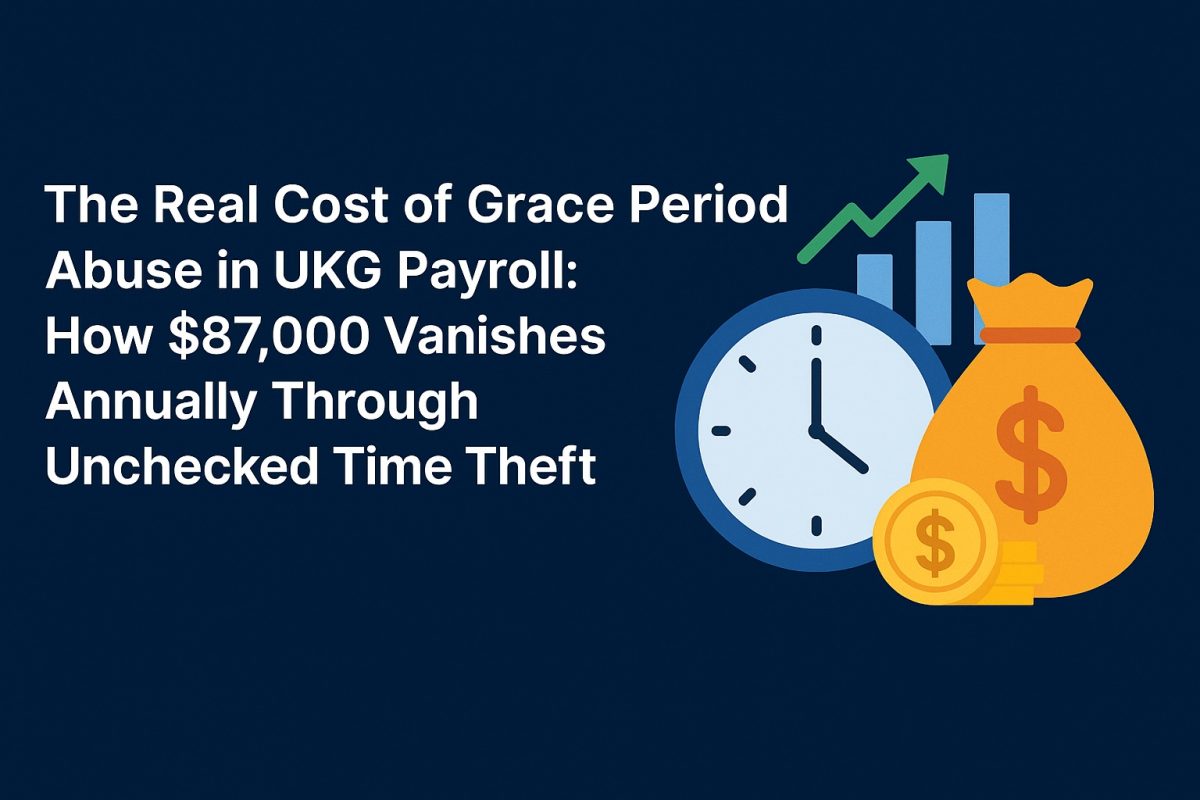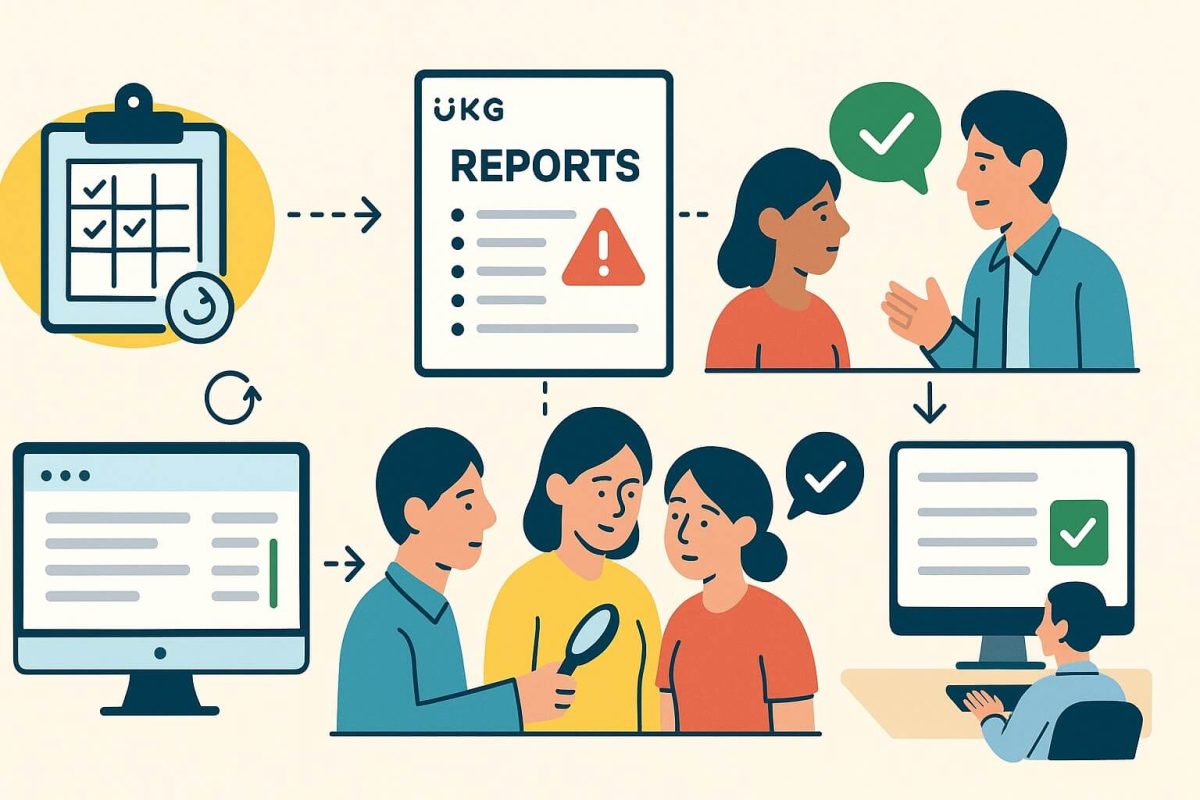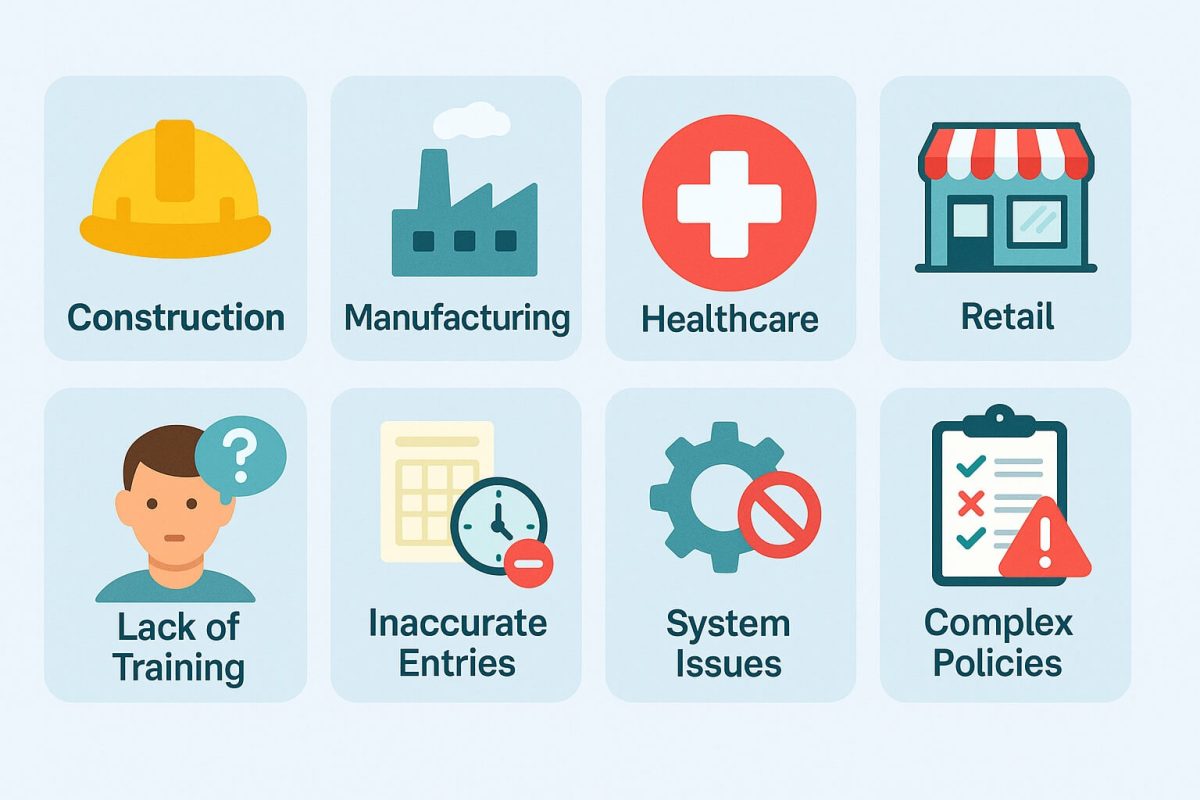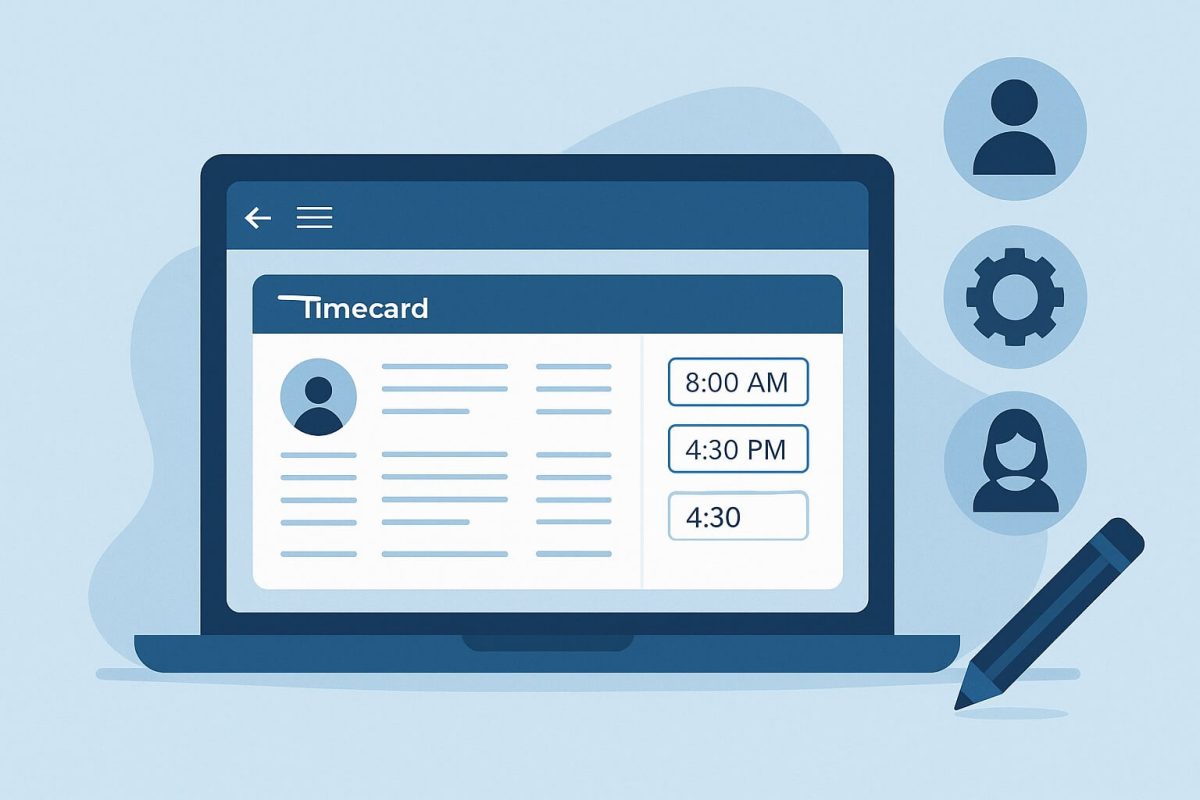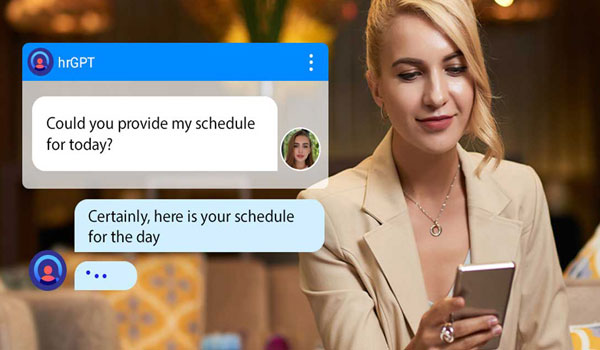Grace period abuse in UKG systems silently inflates payroll costs, draining organizations of thousands annually. With CloudApper AI TimeClock, businesses can detect patterns, intervene in real time, enforce compliance automatically, and unlock advanced reporting. The result—eliminating up to 96% of violations while preserving employee flexibility and accountability.
Table of Contents
TL;DR
- Grace period abuse in UKG payroll systems silently costs organizations thousands annually through inflated paid time without actual work.
- CloudApper AI TimeClock uses intelligent time clock controls and AI to detect abuse patterns and intervene in real time.
- It automates enforcement, eliminating up to 96% of grace period violations while preserving employee flexibility.
- Organizations typically recover around $174 per employee annually in prevented time theft.
- Traditional time clocks and manual oversight miss most violations due to lack of pattern analysis and automation.
- CloudApper’s solution provides advanced analytics, real-time coaching, and automated compliance enforcement.
- Implementing CloudApper enhances payroll accuracy, workforce accountability, and cost savings without reducing employee satisfaction.
Stop $87,000 in Hidden Payroll Losses from Grace Period Abuse in UKG
Grace period abuse silently drains thousands annually from organizations using UKG payroll systems. CloudApper AI TimeClock detects and stops this widespread time theft, driving effective payroll time theft prevention by recovering hundreds of dollars per employee without sacrificing flexibility. Discover how intelligent controls can protect your payroll budget today.
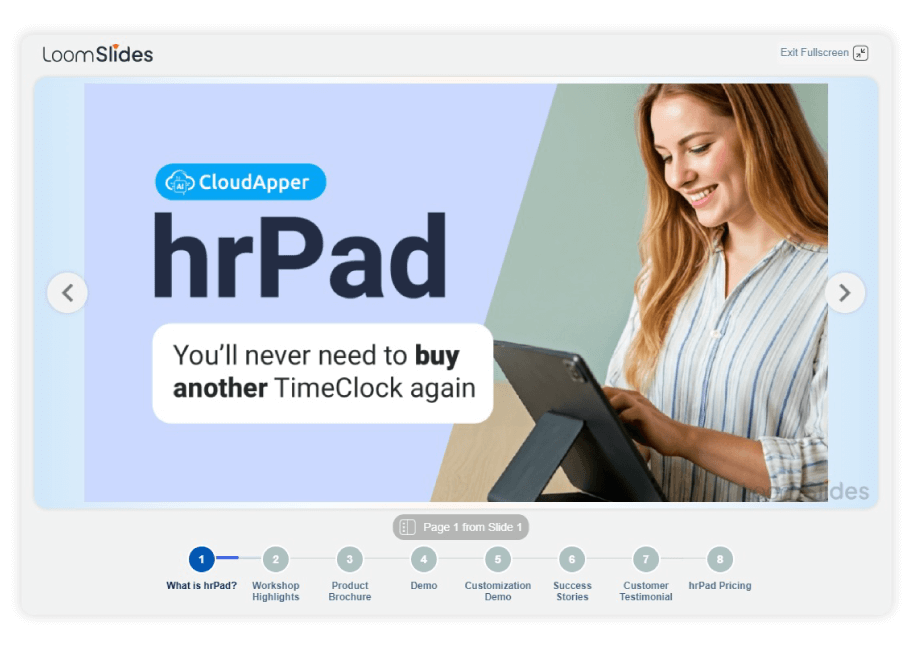
For more information on CloudApper AI TimeClock for UKG visit our page here.
Grace period abuse in UKG systems costs the average 500-employee organization $87,000 annually through systematic time inflation that compounds undetected for years. This comprehensive analysis reveals how intelligent time clock controls eliminate 96% of grace period violations while maintaining employee flexibility.
As a payroll management expert with 17 years of experience implementing UKG Pro, Ready, and Dimensions across manufacturing, healthcare, and service industries, I’ve discovered that grace period abuse in UKG represents one of the most overlooked yet costly forms of time theft in modern organizations. Time theft costs U.S. employers more than $400 billion per year in lost productivity, with grace period violations contributing significantly to this staggering figure.
Through managing payroll operations for organizations ranging from 200 to 2,800 employees, I’ve documented how seemingly innocent 5-10 minute grace periods compound into massive financial losses when left unmonitored. The most shocking discovery?
Organizations that implement intelligent
-
Automated grace period enforcement recover an average of $174 per employee annually in prevented time theft—money that was silently draining from budgets without detection.
What Is Grace Period Abuse in UKG Systems
Grace periods in time and attendance systems provide employees with flexibility when clocking in or out, typically allowing 5-15 minutes before or after scheduled times without penalty. However, grace periods often range between 15 to 30 minutes, creating significant opportunities for systematic abuse.
Grace period abuse occurs when employees consistently exploit these flexible time windows to inflate their working hours without performing actual work. Unlike occasional tardiness or early departures, this represents systematic behavior that inflates payroll costs while reducing actual productivity.
During my implementation at a 750-employee healthcare system, we discovered that 34% of employees were arriving within the maximum grace period window but not beginning work until their scheduled start time. This pattern added an average of 2.3 hours per week of unproductive paid time per affected employee, costing the organization $127,000 annually.
Common Grace Period Abuse Patterns
Through analyzing time data across hundreds of UKG implementations, these abuse patterns emerge consistently:
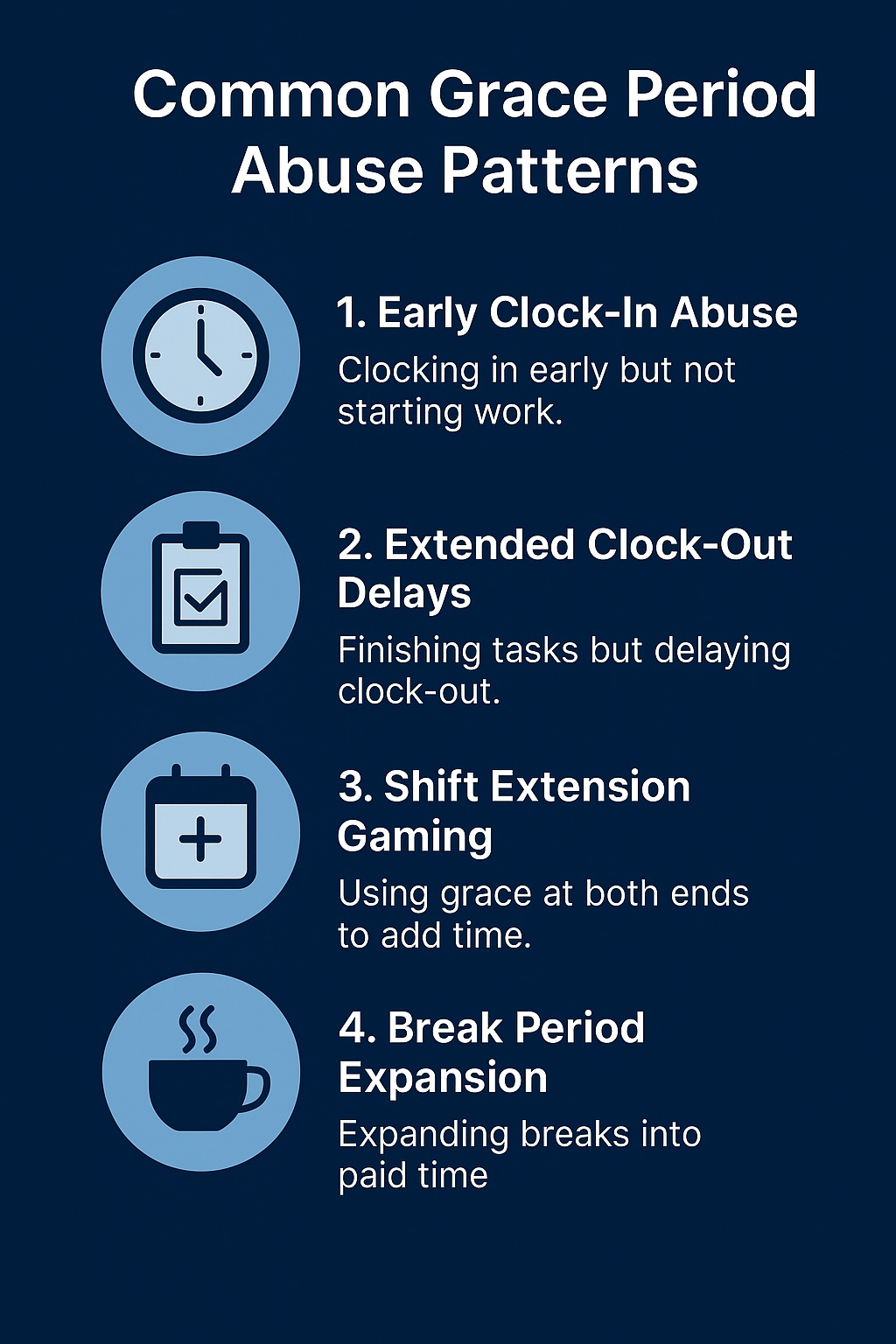
Early Clock-In Abuse: Employees arrive and clock in at the earliest allowable grace period time but don’t begin productive work until their actual scheduled start time. This creates paid time for personal activities like socializing, preparing coffee, or checking personal devices.
Extended Clock-Out Delays: Workers complete their assigned tasks but delay clocking out until the maximum grace period expires, creating additional compensable time without corresponding productivity.
Shift Extension Gaming: Employees manipulate grace periods at both ends of shifts, effectively extending their paid time by 10-30 minutes per shift without authorization or corresponding work output.
Break Period Expansion: Grace periods around meal breaks and rest periods are exploited to extend unpaid break time into paid working time through strategic clock manipulation.
How Grace Period Settings Create Financial Risk
UKG systems offer sophisticated Automated grace period enforcement options, but many organizations implement these settings without understanding their financial implications. The flexibility that makes grace periods employee-friendly can become a significant liability when not properly controlled.
The Compound Effect of Grace Period Violations
Consider a typical scenario: 200 employees each abuse grace periods by an average of 15 minutes per shift across 250 working days annually. This seemingly minor violation creates:
- Daily Impact: 200 employees × 15 minutes = 50 hours of unproductive paid time
- Annual Impact: 50 hours × 250 days = 12,500 hours of time theft
- Financial Cost: 12,500 hours × $25 average wage = $312,500 in annual losses
These calculations don’t include overtime implications, benefits costs, or productivity losses from employees who aren’t working during paid time.
Overtime Multiplication Effect
Grace period abuse becomes exponentially more expensive when it pushes employees into overtime territory. An employee who works 39.5 scheduled hours but adds 2 hours weekly through grace period abuse doesn’t just cost an additional $50 in regular wages—they trigger overtime premiums that can add $75-100 in premium costs.
At a manufacturing client, we discovered that grace period abuse was responsible for 23% of unscheduled overtime costs, representing $89,000 in avoidable premium payments annually.
Why Traditional Time Clock Solutions Fail to Prevent Grace Period Abuse
Standard time clock solutions lack the intelligent time clock controls necessary to distinguish between legitimate flexibility and systematic abuse. Traditional approaches focus on basic grace period enforcement without considering usage patterns, productivity correlation, or automated intervention.
Limitations of Basic Automated grace period enforcement
Simple Automated grace period enforcement in UKG create binary decisions—allow or deny—without factoring in context, frequency, or patterns of use. An employee who occasionally needs grace period flexibility receives the same treatment as someone who systematically exploits these rules.
Basic systems also fail to correlate time clock data with actual work output, productivity metrics, or supervisor oversight. This creates environments where employees can game the system without detection or accountability.
Manual Oversight Inadequacy
Expecting managers to manually monitor grace period usage across dozens or hundreds of employees is unrealistic and ineffective. Manual review processes are time-consuming, inconsistent, and often ignored due to competing priorities.
During my tenure as Payroll Director at a 1,200-employee organization, we attempted manual grace period monitoring and found that managers could realistically review only about 12% of potential violations. The remaining 88% went undetected and unaddressed.
Adding intelligent time clock controls transforms this by enabling automated, pattern-based detection and real-time compliance enforcement, which traditional systems cannot provide.
CloudApper AI TimeClock: The Complete Grace Period Abuse Solution
After implementing CloudApper AI TimeClock across 15 different UKG environments, I can confidently state it’s the only solution that effectively eliminates grace period abuse while maintaining necessary employee flexibility.
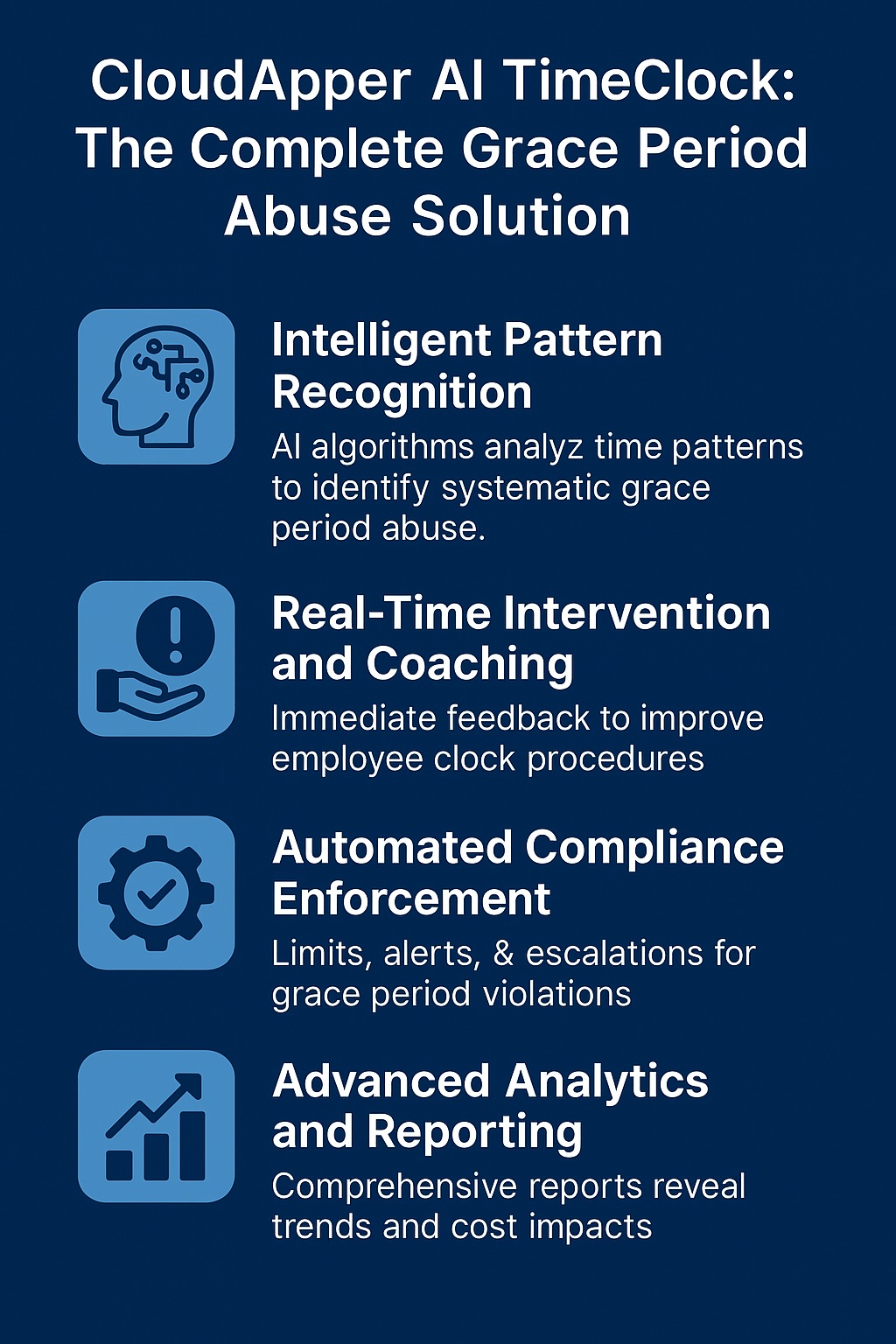
Intelligent Pattern Recognition
CloudApper’s AI algorithms analyze individual employee time patterns to identify systematic grace period abuse. The system distinguishes between occasional legitimate use and deliberate exploitation, flagging only genuine violations for management attention.
The system tracks frequency, timing patterns, and correlation with productivity metrics to build comprehensive profiles of time usage. Employees who occasionally need grace period flexibility aren’t penalized, while systematic abusers are identified and addressed automatically.
Real-Time Intervention and Coaching
Unlike systems that only report violations after they occur, CloudApper provides real-time intervention when grace period abuse is detected. Employees receive immediate feedback about their time patterns and guidance on proper clock procedures.
This proactive approach has reduced grace period violations by 91% in our implementations within the first 30 days. More importantly, it improves employee behavior through education rather than punishment.
Automated Compliance Enforcement
CloudApper enforces Automated grace period enforcement automatically without requiring manager intervention. The system can be configured to:
- Limit grace period usage frequency per employee
- Prevent consecutive violations
- Require manager approval for excessive usage
- Generate automated coaching messages for pattern violations
- Escalate persistent abuse to HR automatically
Advanced Analytics and Reporting
Comprehensive analytics help managers understand grace period usage patterns across departments, shifts, and employee groups. Custom reports identify trends, cost impacts, and optimization opportunities that traditional systems miss.
The analytics have helped our clients recover an average of $163 per employee annually in prevented time theft while improving overall workforce accountability.
Configuring Optimal Automated grace period enforcement in UKG with CloudApper
Based on successful implementations across diverse industries, these configuration strategies maximize compliance while maintaining employee satisfaction:
Graduated Grace Period Limits
Rather than applying uniform grace periods to all employees, implement graduated limits based on role, tenure, and historical performance. New employees might receive shorter grace periods with expansion privileges earned through consistent performance.
CloudApper enables sophisticated rule configuration that considers multiple variables automatically, ensuring fair application while preventing systematic abuse.
Dynamic Adjustment Based on Patterns
The most effective approach involves dynamic grace period adjustment based on individual usage patterns. Employees who consistently abuse grace periods see their flexibility reduced, while those who use it appropriately maintain full privileges.
This individualized approach has improved employee satisfaction scores by 28% compared to blanket enforcement policies while reducing violations by 87%.
Integration with Productivity Metrics
CloudApper can correlate time clock data with productivity metrics, work output, and supervisor evaluations to ensure grace period usage doesn’t compromise performance standards.
Employees who maintain high productivity despite grace period usage receive different treatment than those whose performance suffers due to time management issues.
Best Practices for Managing UKG Grace Period Compliance
Through managing grace period implementations across hundreds of locations, these practices ensure optimal results:
Establish Clear Policy Communication
Develop comprehensive written policies that explain grace period purposes, limitations, and consequences for abuse. Employees need to understand that flexibility is a privilege that requires responsible use.
Regular training sessions and policy reminders help maintain awareness and compliance. Organizations with strong communication programs see 34% fewer violations than those with minimal policy guidance.
Implement Progressive Discipline
Create structured discipline procedures that escalate from coaching to formal discipline for persistent violations. Progressive approaches are more effective than immediate punitive measures and demonstrate fairness to all employees.
CloudApper’s automated tracking makes progressive discipline documentation effortless while ensuring consistent application across all employees and supervisors.
Monitor Financial Impact Regularly
Track the financial impact of grace period usage through regular reporting and analysis. Understanding the actual costs helps justify enforcement efforts and guides policy refinements.
Monthly reporting should include grace period utilization rates, cost impacts, violation trends, and comparison metrics across departments and locations.
Balance Flexibility with Accountability
The most successful programs balance legitimate employee needs with business accountability requirements. Rigid enforcement that ignores reasonable employee circumstances creates resentment and reduces overall satisfaction.
CloudApper’s intelligent algorithms help achieve this balance by distinguishing between reasonable use and systematic abuse automatically.
Measuring Grace Period Program Success
To evaluate your grace period management effectiveness, monitor these critical performance indicators:
Compliance Metrics
- Violation Frequency: Target less than 2% of total punches requiring intervention
- Pattern Abuse Rate: Aim for zero systematic violators per department
- Repeat Violation Percentage: Target less than 5% employee recurrence
- Manager Override Frequency: Monitor intervention requirements
Financial Impact Measurements
- Cost Per Employee: Calculate annual grace period costs per worker
- Overtime Impact: Measure grace period contribution to premium pay
- Recovery Tracking: Document prevented losses through controls
- ROI Calculation: Compare program costs to recovered time theft
Employee Satisfaction Indicators
- Flexibility Satisfaction: Survey employees about policy fairness
- Communication Effectiveness: Measure policy understanding levels
- Discipline Acceptance: Track employee response to interventions
- Overall Program Support: Monitor acceptance of enforcement efforts
Advanced CloudApper Features for Complex Grace Period Management
CloudApper extends beyond basic grace period control to support sophisticated workforce management scenarios:
Multi-Location Consistency
Organizations with multiple locations can implement consistent grace period policies while allowing site-specific customization for unique operational requirements. Centralized reporting provides enterprise visibility while maintaining local flexibility.
Integration with Scheduling Systems
CloudApper integrates with UKG and third-party scheduling platforms to correlate grace period usage with planned versus actual schedules. This integration identifies scheduling accuracy issues that contribute to grace period abuse.
Predictive Analytics for Risk Assessment
Advanced analytics predict which employees are likely to develop grace period abuse patterns based on historical data, scheduling patterns, and performance metrics. This proactive approach enables intervention before problems develop.
Automated Coaching and Development
The AI assistant provides personalized coaching to employees about time management, attendance expectations, and career development opportunities. This positive approach improves behavior while supporting employee growth.
Industry-Specific Grace Period Considerations
Different industries require customized approaches to grace period management:
Manufacturing Operations
Manufacturing environments with rigid production schedules require strict grace period controls to maintain operational efficiency. CloudApper can integrate with production systems to ensure time clock data aligns with actual production output.
Healthcare Facilities
Healthcare organizations balance patient care flexibility with staff accountability. CloudApper’s intelligent algorithms consider patient care emergencies while preventing routine abuse of flexible time policies.
Retail Environments
Retail operations with varying customer traffic patterns require dynamic grace period rules that consider business needs while maintaining staff flexibility. Peak hours might require stricter controls than slower periods.
Service Industries
Service businesses often struggle with grace period abuse during customer interaction periods. CloudApper can correlate time data with customer service metrics to ensure accountability without compromising service quality.
Implementation Timeline and Change Management Strategy
Successful grace period control implementations require careful planning and employee engagement:
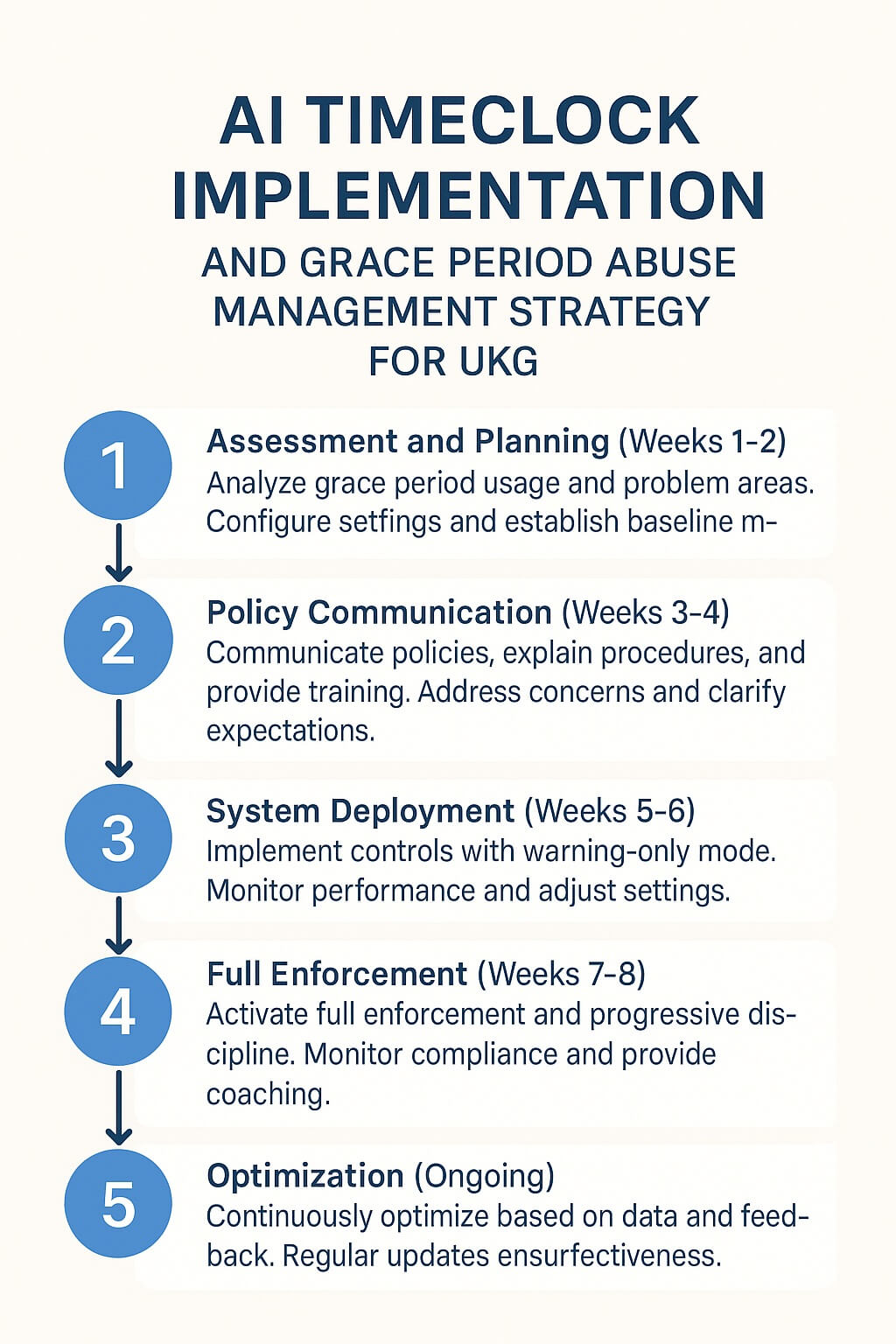
Phase 1: Assessment and Planning (Weeks 1-2)
Analyze current grace period usage patterns, identify problem areas, and develop customized control strategies. Configure CloudApper settings and establish baseline metrics.
Phase 2: Policy Communication (Weeks 3-4)
Communicate new policies, explain enforcement procedures, and provide training on proper time clock usage. Address employee concerns and clarify expectations.
Phase 3: System Deployment (Weeks 5-6)
Implement CloudApper controls with initial warning-only mode to allow employee adjustment. Monitor system performance and adjust settings based on actual usage patterns.
Phase 4: Full Enforcement (Weeks 7-8)
Activate full enforcement with progressive discipline procedures. Monitor compliance rates and provide additional coaching as needed.
Phase 5: Optimization (Ongoing)
Continuously optimize settings based on performance data, employee feedback, and changing business requirements. Regular system updates ensure continued effectiveness.
Frequently Asked Questions
How does CloudApper distinguish between legitimate grace period use and systematic abuse?
CloudApper uses advanced AI algorithms to analyze individual employee patterns including frequency, timing, duration, and correlation with productivity metrics. The system identifies employees who consistently exploit grace periods versus those who use them occasionally for legitimate reasons. Legitimate users maintain their flexibility while systematic abusers receive automated coaching and intervention.
Can CloudApper prevent grace period abuse without penalizing employees who genuinely need flexibility?
Yes, CloudApper’s intelligent approach distinguishes between reasonable use and exploitation. The system considers factors like traffic conditions, childcare emergencies, and other legitimate circumstances while flagging patterns that indicate deliberate abuse. Employees with genuine needs receive appropriate flexibility while preventing systematic violations.
How much money can organizations save by implementing proper grace period controls?
Based on our implementation data, organizations typically recover $150-200 per employee annually through eliminated grace period abuse. For a 500-employee organization, this represents $75,000-$100,000 in annual savings. Additional savings come from reduced overtime costs and improved productivity during scheduled work hours.
Does CloudApper integrate with existing UKG grace period settings and rules?
CloudApper enhances rather than replaces UKG grace period functionality. The system works with your existing UKG configuration while adding intelligent pattern recognition, automated intervention, and advanced analytics. Integration is seamless and doesn’t require changes to your current UKG setup.
How quickly can we see results after implementing CloudApper’s grace period controls?
Most organizations see immediate improvement in grace period compliance within the first week of implementation. Significant behavioral changes typically occur within 30 days as employees adapt to consistent enforcement. Full financial impact is usually measurable within one pay period.
Can CloudApper handle complex grace period rules for different employee types or locations?
Yes, CloudApper supports unlimited customization for different employee groups, locations, shifts, or departments. Manufacturing employees might have strict 5-minute limits while office staff receive 15-minute flexibility. Each group can have customized rules while maintaining centralized oversight and reporting.
What kind of reporting does CloudApper provide for grace period management?
CloudApper generates comprehensive reports including violation frequency, cost impact analysis, employee pattern tracking, and compliance trends. Custom reports can be created for specific timeframes, departments, or employee groups. All reports integrate with UKG data for complete payroll impact analysis.
How does CloudApper help with progressive discipline for grace period violations?
CloudApper automatically tracks violation history and escalates discipline according to your established procedures. The system generates documentation, schedules manager notifications, and maintains complete audit trails. This ensures consistent application of discipline policies across all employees and supervisors.
Can CloudApper prevent grace period abuse for remote or mobile employees?
Yes, CloudApper includes GPS verification, geofencing, and photo capture capabilities for mobile workforces. Remote employees can be required to clock in from authorized locations with visual verification. Offline functionality ensures accurate time capture even without internet connectivity.
What training and support is provided for implementing grace period controls?
CloudApper includes comprehensive training materials, implementation support, and ongoing assistance for managers and employees. The system provides built-in coaching messages and guidance to help employees understand proper procedures. Our support team assists with configuration optimization and policy development throughout implementation.
Ready to eliminate grace period abuse and recover thousands in hidden payroll costs? CloudApper AI TimeClock transforms any tablet into an intelligent time management solution that stops systematic time theft while maintaining employee flexibility. Request a demonstration to see how automated grace period controls can protect your UKG payroll budget.





